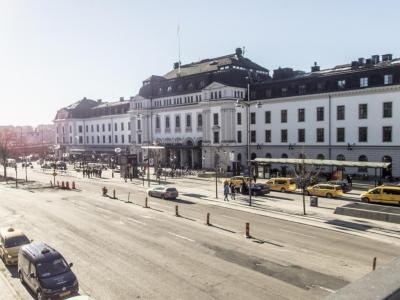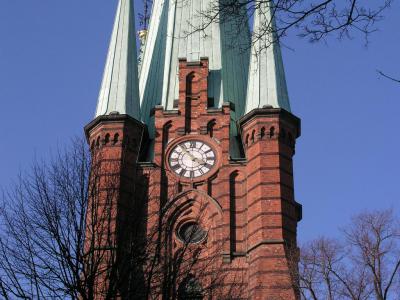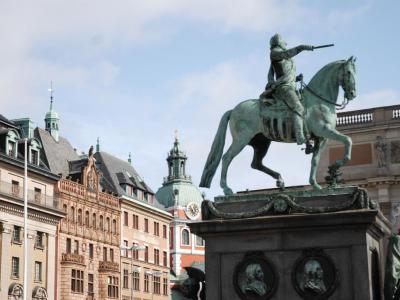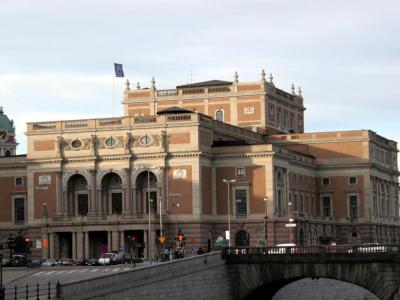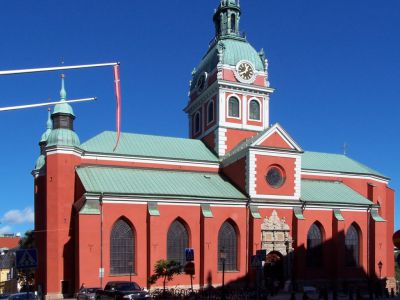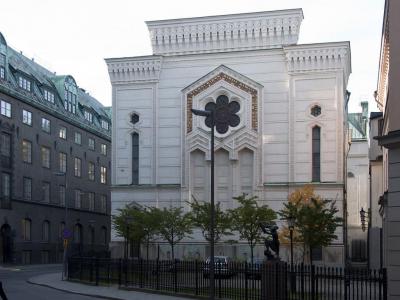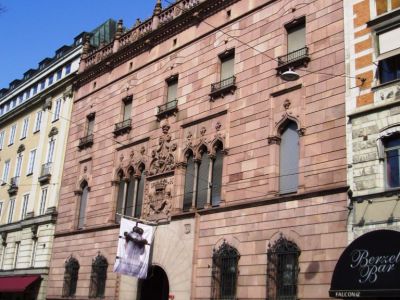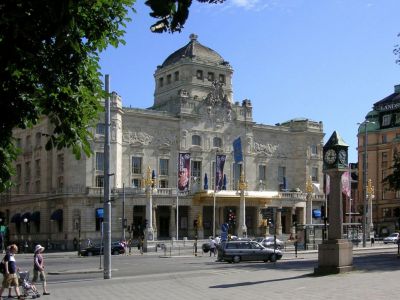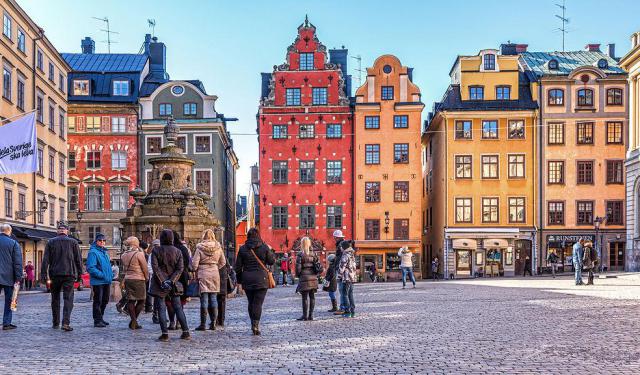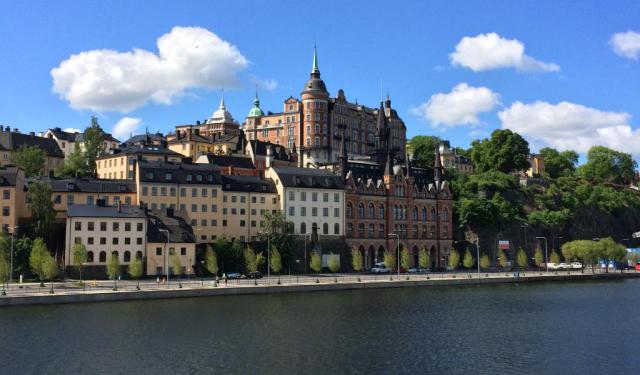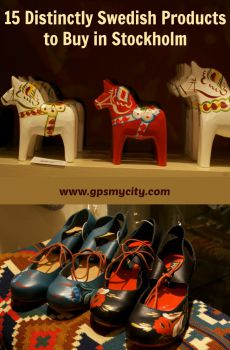Audio Guide: City Center (Norrmalm) Walk (Self Guided), Stockholm
Once upon a cobblestone, Norrmalm wasn’t even part of Stockholm. Up until 1635, it was a town of its own before it decided to join the “big leagues.” Fast forward a few centuries, and this central district has become a spirited jumble of old-world charm and postwar boldness. The 1950s and ‘60s came in swinging wrecking balls, knocking down swathes of old buildings to make room for future developments. But despite all that demolition spree, Norrmalm has retained its architectural cool, with styles ranging from Late Gothic to Renaissance and Baroque just casually showing off on street corners.
The perfect entry point to the area is Stockholm Central Station. More than just a place to catch a train, it’s the city’s beating heart, pumping commuters and tourists in all directions. Step outside, and there’s Saint Clare Church, standing tall in Baroque elegance, as if to say, “Yes, I’ve been around and seen things.”
Wander a bit further and you’ll hit the House of Culture-a modern glass-and-concrete think tank where art, books, and big ideas swirl together in stylish harmony. Then there’s Gustav Adolfs Torg, a square so lively it practically hums, framed by cafes, gossip, and a healthy dose of people-watching.
Feeling theatrical? You’re in luck. The Royal Swedish Opera and the Royal Dramatic Theatre are both within walking distance-grand stages, red velvet, and performances that hit you right in the feelings.
But Norrmalm doesn’t just put on a show-it also offers a spiritual pause. Saint James's Church and the Stockholm Synagogue provide peaceful retreats when the city buzz gets too loud.
For those craving a brush with aristocracy, the Hallwyl Museum is a treasure box of late 19th-century luxury, while the National Museum of Fine Arts lets you time-travel through centuries of Swedish and international masterpieces without ever leaving the riverbank.
Norrmalm is fit to deliver equally to anyone who's a culture-hungry explorer or just in it for the pretty buildings. It's the stylish handshake between Stockholm's past and future-and frankly, it’s worth losing yourself in...
The perfect entry point to the area is Stockholm Central Station. More than just a place to catch a train, it’s the city’s beating heart, pumping commuters and tourists in all directions. Step outside, and there’s Saint Clare Church, standing tall in Baroque elegance, as if to say, “Yes, I’ve been around and seen things.”
Wander a bit further and you’ll hit the House of Culture-a modern glass-and-concrete think tank where art, books, and big ideas swirl together in stylish harmony. Then there’s Gustav Adolfs Torg, a square so lively it practically hums, framed by cafes, gossip, and a healthy dose of people-watching.
Feeling theatrical? You’re in luck. The Royal Swedish Opera and the Royal Dramatic Theatre are both within walking distance-grand stages, red velvet, and performances that hit you right in the feelings.
But Norrmalm doesn’t just put on a show-it also offers a spiritual pause. Saint James's Church and the Stockholm Synagogue provide peaceful retreats when the city buzz gets too loud.
For those craving a brush with aristocracy, the Hallwyl Museum is a treasure box of late 19th-century luxury, while the National Museum of Fine Arts lets you time-travel through centuries of Swedish and international masterpieces without ever leaving the riverbank.
Norrmalm is fit to deliver equally to anyone who's a culture-hungry explorer or just in it for the pretty buildings. It's the stylish handshake between Stockholm's past and future-and frankly, it’s worth losing yourself in...
How it works: Download the app "GPSmyCity: Walks in 1K+ Cities" from Apple App Store or Google Play Store to your mobile phone or tablet. The app turns your mobile device into a personal tour guide and its built-in GPS navigation functions guide you from one tour stop to next. The app works offline, so no data plan is needed when traveling abroad.
City Center (Norrmalm) Walk Map
Guide Name: City Center (Norrmalm) Walk
Guide Location: Sweden » Stockholm (See other walking tours in Stockholm)
Guide Type: Self-guided Walking Tour (Sightseeing)
# of Attractions: 10
Tour Duration: 2 Hour(s)
Travel Distance: 3.0 Km or 1.9 Miles
Author: rose
Sight(s) Featured in This Guide:
Guide Location: Sweden » Stockholm (See other walking tours in Stockholm)
Guide Type: Self-guided Walking Tour (Sightseeing)
# of Attractions: 10
Tour Duration: 2 Hour(s)
Travel Distance: 3.0 Km or 1.9 Miles
Author: rose
Sight(s) Featured in This Guide:
- Stockholm Central Station
- Klara Kyrka (Saint Clare Church)
- Kulturhuset (House of Culture)
- Gustav Adolfs Torg (Square)
- Royal Swedish Opera
- Sankt Jacobs Kyrka (Saint James's Church)
- Stockholm Synagogue
- Hallwylska Palatset (Hallwyl Palace)
- Royal Dramatic Theatre
- Nationalmuseet (National Museum of Fine Arts)
1) Stockholm Central Station
If you’ve ever felt overwhelmed at Stockholm Central Station, don’t worry-you’re in good company. Designed by Adolf W. Edelsvärd and opened in 1871, this grand old hub has seen more comings and goings than a soap opera love triangle. These days, over 200,000 people sweep through its halls daily-170,000 of them actually catching trains, while the rest are probably just wondering where the coffee is...
Originally, trains pulled straight into the station, but that changed in the roaring 1920s. Between 1925 and 1927, the tracks were shifted westward, and the cavernous old track hall was turned into a majestic waiting room-because why not lounge in style while missing your train? They even added a south pavilion, now used for conferences and royal pit stops. Yes, the Swedish Royal Family has its own VIP lounge here, because... why not?
The building got a bit of a facelift in 1951, losing some ornamentation to the gods of post-war minimalism. Then, in 1958, a tunnel was added to connect it to T-Centralen, Stockholm’s busy metro hub-perfect for those who enjoy long underground walks with confusing signage.
And right in the middle of it all is the so-called “Ring”-a round space fondly mocked by locals as “the spittoon.” Not exactly flattering, but hey, every icon has its nickname...
More recently, the station’s gone green. In 2011, the Swedish railway property management folks had a brainwave: use the body heat of the endless stream of commuters to warm a nearby office building. Eco-friendly and slightly creepy-but impressive nonetheless.
And just to keep things cheeky, during the 2012 renovation of the front façade, they popped a pair of earmuffs on the statue of railway legend Nils Ericson, a prominent Swedish mechanical engineer and railway builder, along with a speech bubble that read, “Oh my gosh, what a noise.” Proof that even Sweden’s most dignified landmarks aren’t above a little self-mockery.
Originally, trains pulled straight into the station, but that changed in the roaring 1920s. Between 1925 and 1927, the tracks were shifted westward, and the cavernous old track hall was turned into a majestic waiting room-because why not lounge in style while missing your train? They even added a south pavilion, now used for conferences and royal pit stops. Yes, the Swedish Royal Family has its own VIP lounge here, because... why not?
The building got a bit of a facelift in 1951, losing some ornamentation to the gods of post-war minimalism. Then, in 1958, a tunnel was added to connect it to T-Centralen, Stockholm’s busy metro hub-perfect for those who enjoy long underground walks with confusing signage.
And right in the middle of it all is the so-called “Ring”-a round space fondly mocked by locals as “the spittoon.” Not exactly flattering, but hey, every icon has its nickname...
More recently, the station’s gone green. In 2011, the Swedish railway property management folks had a brainwave: use the body heat of the endless stream of commuters to warm a nearby office building. Eco-friendly and slightly creepy-but impressive nonetheless.
And just to keep things cheeky, during the 2012 renovation of the front façade, they popped a pair of earmuffs on the statue of railway legend Nils Ericson, a prominent Swedish mechanical engineer and railway builder, along with a speech bubble that read, “Oh my gosh, what a noise.” Proof that even Sweden’s most dignified landmarks aren’t above a little self-mockery.
2) Klara Kyrka (Saint Clare Church)
Tucked amid the modern hustle of Stockholm’s lower Norrmalm, the Church of Saint Clare rises like a pious time traveler who forgot to update their outfit since the 1500s. And don’t be misled by the neighboring skyscrapers-this place has been around since the 1280s, when it was originally part of a wealthy Roman Catholic convent dedicated to Saint Clare. The area got its name from the convent, and things were going swimmingly until the 15th century, when fortunes turned, upkeep slipped, and everything started crumbling like day-old crispbread.
In 1527, King Gustav Vasa entered the scene, kicked off the Protestant Reformation, and razed whatever was left of the original church and the convent. But all was not lost. In 1572, King Johan III decided Stockholm needed a little divine real estate again and thus laid the foundations for the current structure.
Trouble didn’t stay away long, though. A fire in the mid-1700s scorched the church, but it rose again from the ashes thanks to the 19th-century glow-up. That era gave the interior its golden glam makeover: warm hues, stunning stained glass, and a pulpit so gilded it could make Versailles blush.
Outside, the showstopper is the 116-meter tower-an 1880s addition that’s been poking at Stockholm’s skyline ever since. The churchyard is no less storied, hosting the bones of Sweden’s beloved bard, Carl Michael Bellman.
Now nestled among office blocks and shopping centers, Saint Clare's Church is one of the few historical holdouts still keeping watch over the ever-changing cityscape. So, whenever you pass by its towering spire, take a moment to take note-this landmark is Stockholm’s quiet reminder that faith and a little flair can survive fire and just about anything...
In 1527, King Gustav Vasa entered the scene, kicked off the Protestant Reformation, and razed whatever was left of the original church and the convent. But all was not lost. In 1572, King Johan III decided Stockholm needed a little divine real estate again and thus laid the foundations for the current structure.
Trouble didn’t stay away long, though. A fire in the mid-1700s scorched the church, but it rose again from the ashes thanks to the 19th-century glow-up. That era gave the interior its golden glam makeover: warm hues, stunning stained glass, and a pulpit so gilded it could make Versailles blush.
Outside, the showstopper is the 116-meter tower-an 1880s addition that’s been poking at Stockholm’s skyline ever since. The churchyard is no less storied, hosting the bones of Sweden’s beloved bard, Carl Michael Bellman.
Now nestled among office blocks and shopping centers, Saint Clare's Church is one of the few historical holdouts still keeping watch over the ever-changing cityscape. So, whenever you pass by its towering spire, take a moment to take note-this landmark is Stockholm’s quiet reminder that faith and a little flair can survive fire and just about anything...
3) Kulturhuset (House of Culture)
Imagine a place where politics once bunked with performance art, where glass walls wink at the public, and where a simple stroll could land you in the middle of a flamenco, a fashion show, or a philosophy debate. Welcome to the House of Culture, Stockholm’s cultural powerhouse!
Surprisingly, for a brief but glorious chapter before 1983, it also served as an unexpected crash pad for the Swedish Parliament. Yes, really. While their official quarters were under construction, lawmakers camped out right here, proving that democracy can't do without a bit of drama...
The visionary behind this transparent temple of culture was architect Peter Celsing. He won a 1966 design competition with one grand idea: to build a house where all of Stockholm’s art could come out and play. His creation faces Sergels Square with a bold glass façade-a window into the soul of the city that glows at night like a lantern full of possibilities.
Inside, it’s a creative beehive. Eight stages buzz with over 2,000 performances a year, from experimental theater to world-class dance-thanks to the in-house dance company that’s been pirouetting across the premises since 2013. There are six ever-changing art, design, and fashion exhibitions annually, and six specialty libraries to match, including three just for kids and teens-because culture doesn’t come with an age limit...
And then there’s the rest: a theater, restaurants, cozy cafes, a Tourist Center, and even shops for the curious and caffeinated alike.
Every day, the House of Culture offers a dozen doors into something unexpected. Film, books, debates, music, exhibitions, and maybe-just maybe-that one magical moment you didn’t know you were looking for.
Surprisingly, for a brief but glorious chapter before 1983, it also served as an unexpected crash pad for the Swedish Parliament. Yes, really. While their official quarters were under construction, lawmakers camped out right here, proving that democracy can't do without a bit of drama...
The visionary behind this transparent temple of culture was architect Peter Celsing. He won a 1966 design competition with one grand idea: to build a house where all of Stockholm’s art could come out and play. His creation faces Sergels Square with a bold glass façade-a window into the soul of the city that glows at night like a lantern full of possibilities.
Inside, it’s a creative beehive. Eight stages buzz with over 2,000 performances a year, from experimental theater to world-class dance-thanks to the in-house dance company that’s been pirouetting across the premises since 2013. There are six ever-changing art, design, and fashion exhibitions annually, and six specialty libraries to match, including three just for kids and teens-because culture doesn’t come with an age limit...
And then there’s the rest: a theater, restaurants, cozy cafes, a Tourist Center, and even shops for the curious and caffeinated alike.
Every day, the House of Culture offers a dozen doors into something unexpected. Film, books, debates, music, exhibitions, and maybe-just maybe-that one magical moment you didn’t know you were looking for.
4) Gustav Adolfs Torg (Square)
Gustav Adolfs Square-Stockholm’s ultimate power intersection, where history, politics, and perfectly aligned cobblestones meet. Nestled near the Norrbro bridge, this square isn’t just a regular place you pass through-it’s the point Stockholm measures itself from. Literally. While most cities peg distances from the train station, Stockholm prefers a bit more royal flair.
Named in 1805 after King Gustav II Adolf-Sweden’s “Lion of the North” and part-time battlefield legend, full-time national hero-the square proudly hosts an equestrian statue of the king smack in the middle. Crafted by Pierre Hubert L’Archevêque (French by birth, Swedish by sculpting ambition), this statue was cast in 1778 and planted here in 1791. It holds the national title of Sweden’s first equestrian statue (talk about setting the bar with hooves...).
Two bronze lions flank the monument-not your average public art, but replicas of fourth-century originals. The real ones live in the Vatican, probably sipping espresso and avoiding pigeons...
And the surroundings – they're equally grand. You've got the Royal Opera belting out drama to the east, the Ministry of Foreign Affairs housed in the stately Crown Prince's Palace, and the Ministry of Defence keeping a watchful eye. Head just south, and you're at the Riksdag (Parliament) Building and the Royal Palace in Gamla Stan-because nothing says "central" like being a stone’s throw from monarchy, music, and military planning...
In case you're plotting a coup, catching a matinee, or just marveling at lion-adorned monarchs, Gustav Adolfs Square is your compass point. So, stick around-the self-guided tour has plenty more stories to tell.
Named in 1805 after King Gustav II Adolf-Sweden’s “Lion of the North” and part-time battlefield legend, full-time national hero-the square proudly hosts an equestrian statue of the king smack in the middle. Crafted by Pierre Hubert L’Archevêque (French by birth, Swedish by sculpting ambition), this statue was cast in 1778 and planted here in 1791. It holds the national title of Sweden’s first equestrian statue (talk about setting the bar with hooves...).
Two bronze lions flank the monument-not your average public art, but replicas of fourth-century originals. The real ones live in the Vatican, probably sipping espresso and avoiding pigeons...
And the surroundings – they're equally grand. You've got the Royal Opera belting out drama to the east, the Ministry of Foreign Affairs housed in the stately Crown Prince's Palace, and the Ministry of Defence keeping a watchful eye. Head just south, and you're at the Riksdag (Parliament) Building and the Royal Palace in Gamla Stan-because nothing says "central" like being a stone’s throw from monarchy, music, and military planning...
In case you're plotting a coup, catching a matinee, or just marveling at lion-adorned monarchs, Gustav Adolfs Square is your compass point. So, stick around-the self-guided tour has plenty more stories to tell.
5) Royal Swedish Opera
Right in the cultural bloodstream of Stockholm sits the Royal Swedish Opera-a place where velvet curtains, royal boxes, and dramatic high notes have been part of the décor since the 18th century. The venue rubs elbows with serious company: the Royal Palace, the Riksdag, and the Ministry of Foreign Affairs, which lives in the old Crown Prince's Palace just across the square. Not bad neighbors, if you're into monarchy and policymaking...
The whole show began thanks to King Gustav III, who had a flair for theatrics and a passion for founding things. Alongside the Royal Swedish Academy of Music, he launched the opera company in 1773 with "Thetis and Phelée"-the first opera sung in Swedish by actual Swedes. A revolutionary concept at the time.
But Gustav wasn’t content with a one-night gig. He wanted a proper opera house, and by 1782, he had one. Designed by Carl Fredrik Adelcrantz, it came complete with neoclassical swagger, a four-tiered auditorium, and an entrance that looked like it belonged on Mount Olympus. Sadly, that building took its final bow in 1892, making way for a fresh production.
The new house was rolled out in 1897 under King Oscar II. Architect Axel Johan Anderberg kept the classical elegance but trimmed the size, creating a 1,200-seat venue known simply as Operan. Inside: gold-drenched foyers, a marble staircase worthy of dramatic entrances, and the Royal Box. Here, Sweden’s royal family watches the show from a throne-like perch above the orchestra pit.
Over the years, the Royal Swedish Opera has hosted some heavy hitters-both Swedish and international singers-whose vocal firepower is enough to raise the roof (if only it weren’t so historic). Performances are typically sung in their original languages with Swedish subtitles, all backed by the Royal Court Chapel, one of Europe’s oldest orchestras-still going strong after nearly 500 years.
Hot tip:
Grab your tickets online-easy and efficient. Better yet, take a guided tour. You’ll get backstage access, peek into the Royal Box, and see where the magic happens-no crown necessary...
The whole show began thanks to King Gustav III, who had a flair for theatrics and a passion for founding things. Alongside the Royal Swedish Academy of Music, he launched the opera company in 1773 with "Thetis and Phelée"-the first opera sung in Swedish by actual Swedes. A revolutionary concept at the time.
But Gustav wasn’t content with a one-night gig. He wanted a proper opera house, and by 1782, he had one. Designed by Carl Fredrik Adelcrantz, it came complete with neoclassical swagger, a four-tiered auditorium, and an entrance that looked like it belonged on Mount Olympus. Sadly, that building took its final bow in 1892, making way for a fresh production.
The new house was rolled out in 1897 under King Oscar II. Architect Axel Johan Anderberg kept the classical elegance but trimmed the size, creating a 1,200-seat venue known simply as Operan. Inside: gold-drenched foyers, a marble staircase worthy of dramatic entrances, and the Royal Box. Here, Sweden’s royal family watches the show from a throne-like perch above the orchestra pit.
Over the years, the Royal Swedish Opera has hosted some heavy hitters-both Swedish and international singers-whose vocal firepower is enough to raise the roof (if only it weren’t so historic). Performances are typically sung in their original languages with Swedish subtitles, all backed by the Royal Court Chapel, one of Europe’s oldest orchestras-still going strong after nearly 500 years.
Hot tip:
Grab your tickets online-easy and efficient. Better yet, take a guided tour. You’ll get backstage access, peek into the Royal Box, and see where the magic happens-no crown necessary...
6) Sankt Jacobs Kyrka (Saint James's Church)
Standing in the heart of Stockholm-just steps from the Royal Garden and practically within earshot of the Royal Opera-what do you see? A majestic mix of spires and stone known as Saint James’s Church. But let’s be honest, half the population still calls it Saint Jacob’s. Blame it on Swedish grammar, where James and Jacob have been duking it out for linguistic supremacy for centuries.
Dedicated to Saint James the Greater, the patron saint of travelers (so tip your hat if you're just passing through), this church is a historical heavyweight. It took its first architectural baby steps in 1580, commissioned by King John III, and then proceeded to take the scenic route to completion. Picture a group project where no one could agree on the style: Late Gothic here, Renaissance there, and a strong Baroque finish. No fewer than six architects left their mark, including Willem Boy and Agi Lindegren, just to name-drop a few.
But before all this grandeur, the site was part of Solna parish, as far back as 1311. Then came the Reformation party crasher, King Gustav Vasa, who demolished the original chapel in 1527. What rose in its place was slower to arrive but much harder to ignore. By the time Queen Christina officially opened the doors in 1643, the church still hadn’t finished decorating-classic Stockholm fashion...
Fast forward a few centuries, and the church has had more facelifts than a Swedish pop star: 19th-century overhauls, gas lighting, heating, a shiny new copper roof in 1910-modern touches that kept it from becoming just another pretty relic.
And don’t miss the bust of Jussi Björling out front, Sweden’s beloved tenor, serenading pigeons to this day.
If you're wandering Stockholm with a curious heart and tired feet, please note that Saint James’s Church isn’t just another old building-it’s a time capsule wrapped in stone and song. So, check it out and be surprised what the past has to say...
Dedicated to Saint James the Greater, the patron saint of travelers (so tip your hat if you're just passing through), this church is a historical heavyweight. It took its first architectural baby steps in 1580, commissioned by King John III, and then proceeded to take the scenic route to completion. Picture a group project where no one could agree on the style: Late Gothic here, Renaissance there, and a strong Baroque finish. No fewer than six architects left their mark, including Willem Boy and Agi Lindegren, just to name-drop a few.
But before all this grandeur, the site was part of Solna parish, as far back as 1311. Then came the Reformation party crasher, King Gustav Vasa, who demolished the original chapel in 1527. What rose in its place was slower to arrive but much harder to ignore. By the time Queen Christina officially opened the doors in 1643, the church still hadn’t finished decorating-classic Stockholm fashion...
Fast forward a few centuries, and the church has had more facelifts than a Swedish pop star: 19th-century overhauls, gas lighting, heating, a shiny new copper roof in 1910-modern touches that kept it from becoming just another pretty relic.
And don’t miss the bust of Jussi Björling out front, Sweden’s beloved tenor, serenading pigeons to this day.
If you're wandering Stockholm with a curious heart and tired feet, please note that Saint James’s Church isn’t just another old building-it’s a time capsule wrapped in stone and song. So, check it out and be surprised what the past has to say...
7) Stockholm Synagogue
The Great Synagogue of Stockholm is a full-on architectural sermon. Raised between 1867 and 1870, this landmark was the brainchild of Fredrik Wilhelm Scholander, an architect with a flair for the dramatic and a fondness for “Oriental motifs” (or, as he put it, a paraphrase of ancient styles). Imagine a rectangular sanctuary with four towers-each one hiding a spiral staircase like a secret-and you’ve got a Scandinavian echo of the biblical Temple of Jerusalem. With seating for 850 souls, it’s long been the spiritual headquarters for Stockholm’s Jewish community.
And what's particularly fascinating-there’s more below. Literally. Beneath the synagogue lies the Jewish Community Library, a quiet powerhouse of multilingual knowledge, including the private library of Rabbi Marcus Ehrenpreis, who served as Sweden’s Chief Rabbi for nearly four decades. From Hebrew to French, and yes, a healthy dose of Swedish too, the collection is a literary buffet. The library also acts as a gallery, hosting exhibits and annual events focused on Jewish history and heritage.
Now, just outside the main sanctuary, a deeply moving tribute sits quietly but powerfully: the Holocaust Memorial. Carved into the wall between the synagogue and the community hall, it lists the names of over 8,000 Holocaust victims-relatives of Swedish Jews. In 1998, none other than King Carl XVI Gustaf himself unveiled it, marking its national weight with royal solemnity.
And in the basement, alongside all that knowledge, you’ll also find a mikvah, a ritual bath added in 2017-because tradition doesn’t take a sabbatical...
Step inside and you’ll find Hebrew inscriptions etched into the very walls, whispering stories of faith, resilience, and continuity. Recognized as one of the capital’s most historic buildings, the Great Synagogue proudly holds its place in the Swedish Registry of National Historical Buildings.
And what's particularly fascinating-there’s more below. Literally. Beneath the synagogue lies the Jewish Community Library, a quiet powerhouse of multilingual knowledge, including the private library of Rabbi Marcus Ehrenpreis, who served as Sweden’s Chief Rabbi for nearly four decades. From Hebrew to French, and yes, a healthy dose of Swedish too, the collection is a literary buffet. The library also acts as a gallery, hosting exhibits and annual events focused on Jewish history and heritage.
Now, just outside the main sanctuary, a deeply moving tribute sits quietly but powerfully: the Holocaust Memorial. Carved into the wall between the synagogue and the community hall, it lists the names of over 8,000 Holocaust victims-relatives of Swedish Jews. In 1998, none other than King Carl XVI Gustaf himself unveiled it, marking its national weight with royal solemnity.
And in the basement, alongside all that knowledge, you’ll also find a mikvah, a ritual bath added in 2017-because tradition doesn’t take a sabbatical...
Step inside and you’ll find Hebrew inscriptions etched into the very walls, whispering stories of faith, resilience, and continuity. Recognized as one of the capital’s most historic buildings, the Great Synagogue proudly holds its place in the Swedish Registry of National Historical Buildings.
8) Hallwylska Palatset (Hallwyl Palace)
Hallwyl Palace is the Swedish capital’s most lavish time capsule and possibly the most well-appointed winter residence anyone’s ever donated out of sheer cultural guilt.
Built between 1893 and 1898, this neo-everything fantasy was designed by the architect Isak Gustaf Clason for Count Walther von Hallwyl and his formidable wife, Wilhelmina. While Walther got an office, Wilhelmina got... well, all the rest. She filled the palace with a globe-spanning art collection so vast it basically screamed: “Museum me!” And she did.
Wilhelmina, clearly someone who liked to plan ahead, gifted the entire place to the Swedish state in 1920-with one condition: don't touch a thing. It’s the aristocratic equivalent of "leave my room exactly how I left it." Thanks to that insistence, by 1938 the Hallwyl Museum was open to the public, preserving not just furniture and fine art, but also the eccentricities of elite Swedish life at the turn of the 20th century.
Outside, the palace looks like a greatest-hits album of medieval and Renaissance architecture, particularly with a Venetian flair-because if you're going to be dramatic, go all in. Inside, however, it was surprisingly high-tech for its time: electricity, central heating, telephones, bathrooms, and even an elevator added later...
Today, the Hallwyl Collection numbers around 50,000 items, all still lounging in their original opulent surroundings. Step inside, and you're not just visiting a museum-you’re eavesdropping on a very extravagant past that never quite moved out.
Ready to time travel? Come on in and see how the Count's other half really lived-telephones and all...
Built between 1893 and 1898, this neo-everything fantasy was designed by the architect Isak Gustaf Clason for Count Walther von Hallwyl and his formidable wife, Wilhelmina. While Walther got an office, Wilhelmina got... well, all the rest. She filled the palace with a globe-spanning art collection so vast it basically screamed: “Museum me!” And she did.
Wilhelmina, clearly someone who liked to plan ahead, gifted the entire place to the Swedish state in 1920-with one condition: don't touch a thing. It’s the aristocratic equivalent of "leave my room exactly how I left it." Thanks to that insistence, by 1938 the Hallwyl Museum was open to the public, preserving not just furniture and fine art, but also the eccentricities of elite Swedish life at the turn of the 20th century.
Outside, the palace looks like a greatest-hits album of medieval and Renaissance architecture, particularly with a Venetian flair-because if you're going to be dramatic, go all in. Inside, however, it was surprisingly high-tech for its time: electricity, central heating, telephones, bathrooms, and even an elevator added later...
Today, the Hallwyl Collection numbers around 50,000 items, all still lounging in their original opulent surroundings. Step inside, and you're not just visiting a museum-you’re eavesdropping on a very extravagant past that never quite moved out.
Ready to time travel? Come on in and see how the Count's other half really lived-telephones and all...
9) Royal Dramatic Theatre
The Royal Dramatic Theatre (or “Dramaten,” if you want to blend in with the locals), is Sweden’s grand stage for drama and decorum. Founded way back in 1788-when powdered wigs were still in fashion and theater etiquette included not checking your phone-Dramaten has held court as Sweden’s national hub for spoken drama.
Today, it puts on about a thousand performances a year. Yes, a thousand! That’s seven stages, countless standing ovations, and probably a record number of dramatic monologues about love, war, and suspicious family dinners. From Swedish classics to international heavyweights and modern mind-benders, the repertoire is as rich and layered as a well-acted soliloquy.
Since 1908, the theater has occupied its iconic home at Nybroplan, a marble-and-gold Art Nouveau gem designed by Fredrik Lilljekvist. Think white marble, golden flourishes, and the sort of grand staircases that demand a cape and a dramatic pause halfway up. The interiors are dressed to impress, too-with artistic flair courtesy of Carl Milles, Carl Larsson, and even Prince Eugen. If you're visiting, don’t miss the Marble Foyer-perfect for people-watching, pondering art, or dramatically sipping coffee.
Beyond the velvet curtains and standing ovations, Dramaten has also played a starring role in shaping Swedish acting royalty. Its former training academy launched the careers of icons like Greta Garbo, Ingrid Bergman, Max von Sydow, and Bibi Andersson. The school may have spun off in 1967, but its theatrical DNA still runs through the building.
Owned by the state since 1975, Dramaten remains a central character in Sweden’s cultural story-loyal to Gustav III’s original vision, but still willing to try new scripts.
Thinking of visiting? Brush up on your Swedish, for every performance here is in the native tongue. And if you want a backstage pass to the drama behind the drama, guided tours are available year-round. English-language tours are on Saturdays at 5 pm-but book ahead. The theatre may be dramatic, but it doesn’t like surprises.
Today, it puts on about a thousand performances a year. Yes, a thousand! That’s seven stages, countless standing ovations, and probably a record number of dramatic monologues about love, war, and suspicious family dinners. From Swedish classics to international heavyweights and modern mind-benders, the repertoire is as rich and layered as a well-acted soliloquy.
Since 1908, the theater has occupied its iconic home at Nybroplan, a marble-and-gold Art Nouveau gem designed by Fredrik Lilljekvist. Think white marble, golden flourishes, and the sort of grand staircases that demand a cape and a dramatic pause halfway up. The interiors are dressed to impress, too-with artistic flair courtesy of Carl Milles, Carl Larsson, and even Prince Eugen. If you're visiting, don’t miss the Marble Foyer-perfect for people-watching, pondering art, or dramatically sipping coffee.
Beyond the velvet curtains and standing ovations, Dramaten has also played a starring role in shaping Swedish acting royalty. Its former training academy launched the careers of icons like Greta Garbo, Ingrid Bergman, Max von Sydow, and Bibi Andersson. The school may have spun off in 1967, but its theatrical DNA still runs through the building.
Owned by the state since 1975, Dramaten remains a central character in Sweden’s cultural story-loyal to Gustav III’s original vision, but still willing to try new scripts.
Thinking of visiting? Brush up on your Swedish, for every performance here is in the native tongue. And if you want a backstage pass to the drama behind the drama, guided tours are available year-round. English-language tours are on Saturdays at 5 pm-but book ahead. The theatre may be dramatic, but it doesn’t like surprises.
10) Nationalmuseet (National Museum of Fine Arts) (must see)
Tucked away on Stockholm’s Blasieholmen peninsula-just far enough from the tourist bustle to feel cultured but close enough for a scenic detour-the National Museum of Fine Arts, or simply the National Museum, is Sweden’s crown jewel of artistic grandeur. Think of it as the nation’s visual brain: refined, storied, and occasionally dramatic. It all began with generous patrons like King Gustav III and Carl Gustaf Tessin, whose taste for the finer things laid the groundwork for a collection that is as rich as it is eclectic.
Born in 1792 under the very regal name “Royal Museum”, it’s been hoarding beauty and boosting national pride ever since. Its current quarters, opened in 1866, were the brainchild of German architect Friedrich August Stüler, who borrowed a few pages from the northern Italian Renaissance playbook. Outside, it plays it cool with a somewhat restrained façade-but step inside, and you're greeted by a sweeping staircase that practically begs you to ascend like a minor royal.
Like any well-aged institution, the museum’s had a few makeovers over the years. In 1961, it bulked up with more workshops, and by 1996, it was civilized enough to add a restaurant. Then came the big one: a five-year, top-to-bottom renovation, from 2013 to 2018. Now it boasts modern infrastructure, swanky climate controls, proper accessibility, and enough security to make a Bond villain sweat.
But that's not all... The National Museum is more of a cultural empire than a single building. It oversees the National Portrait Gallery at Gripsholm, the Gustavsberg Porcelain Museum, assorted castle collections, and even the Institute Tessin in Paris. Oh, and since 2018, there’s also a satellite location way up north-the National Museum Jamtli in Östersund-because art deserves snow too...
Undoubtedly, today, the National Museum is more than just a vault of masterpieces-it’s a living, breathing celebration of Sweden’s creative soul. So, go on, give it a visit-and don’t forget to check out that staircase...
Born in 1792 under the very regal name “Royal Museum”, it’s been hoarding beauty and boosting national pride ever since. Its current quarters, opened in 1866, were the brainchild of German architect Friedrich August Stüler, who borrowed a few pages from the northern Italian Renaissance playbook. Outside, it plays it cool with a somewhat restrained façade-but step inside, and you're greeted by a sweeping staircase that practically begs you to ascend like a minor royal.
Like any well-aged institution, the museum’s had a few makeovers over the years. In 1961, it bulked up with more workshops, and by 1996, it was civilized enough to add a restaurant. Then came the big one: a five-year, top-to-bottom renovation, from 2013 to 2018. Now it boasts modern infrastructure, swanky climate controls, proper accessibility, and enough security to make a Bond villain sweat.
But that's not all... The National Museum is more of a cultural empire than a single building. It oversees the National Portrait Gallery at Gripsholm, the Gustavsberg Porcelain Museum, assorted castle collections, and even the Institute Tessin in Paris. Oh, and since 2018, there’s also a satellite location way up north-the National Museum Jamtli in Östersund-because art deserves snow too...
Undoubtedly, today, the National Museum is more than just a vault of masterpieces-it’s a living, breathing celebration of Sweden’s creative soul. So, go on, give it a visit-and don’t forget to check out that staircase...
Walking Tours in Stockholm, Sweden
Create Your Own Walk in Stockholm
Creating your own self-guided walk in Stockholm is easy and fun. Choose the city attractions that you want to see and a walk route map will be created just for you. You can even set your hotel as the start point of the walk.
Old Town (Gamla Stan) Walking Tour
Stockholm, established around 1000 AD on an archipelago on the eastern coast of Sweden, flourished due to Viking-established trade routes. Originally a Viking site, it became a key iron trade hub by 1252. The city's name, derived from the Old Norse words for "log islet," reflects its historical significance, as a fortified island used for defense against sea invasions, and its... view more
Tour Duration: 2 Hour(s)
Travel Distance: 2.1 Km or 1.3 Miles
Tour Duration: 2 Hour(s)
Travel Distance: 2.1 Km or 1.3 Miles
The Museums Island Walk
With almost 70 museums in operation, Stockholm is one of the richest (in terms of museums) cities on the planet. The island of Djurgården, a cultural hotspot inside the capital, also known as the Museums Island, is home to an array of museums and other cultural attractions suitable for visitors of all ages.
One of the most renowned venues on the island is Scandinavia’s most popular museum,... view more
Tour Duration: 2 Hour(s)
Travel Distance: 3.3 Km or 2.1 Miles
One of the most renowned venues on the island is Scandinavia’s most popular museum,... view more
Tour Duration: 2 Hour(s)
Travel Distance: 3.3 Km or 2.1 Miles
Sodermalm District Walking Tour
Södermalm, or "Söder" for short, is a borough in central Stockholm, incorporating a large island of the same name (formerly known as "Åsön"). Although considered an island, the water surrounding Södermalm to the north and south does not flow freely but passes through a series of locks. Visitors are charmed by the borough's narrow, cobbled streets and neat squares, as... view more
Tour Duration: 1 Hour(s)
Travel Distance: 2.3 Km or 1.4 Miles
Tour Duration: 1 Hour(s)
Travel Distance: 2.3 Km or 1.4 Miles
Useful Travel Guides for Planning Your Trip
Souvenir Shopping Guide: 15 Distinctly Swedish Products to Buy in Stockholm
If you come to Stockholm on the trail of Karlsson-on-the-Roof character (Swedish: Karlsson på taket), created by Astrid Lindgren, you're bound to enjoy yourself big time! Just don't forget to spare some time for gift shopping, so as to please your loved ones back home. In doing so, you...
The Most Popular Cities
/ view all



